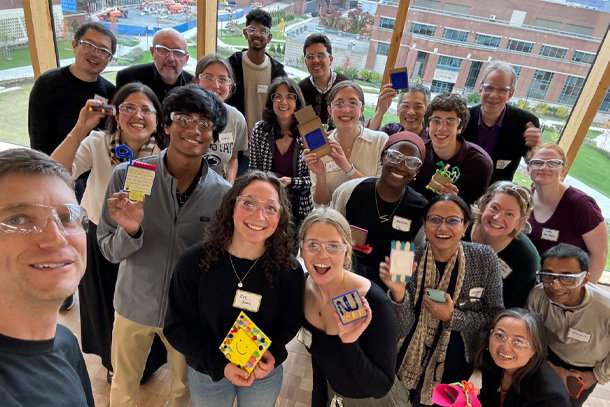
Around 115 people participated in the Global Design Thinking Alliance conference, hosted by the Penn State Learning Factory Oct. 21-22, with about 50 in-person participants. Credit: Provided by Matt Parkinson
Learning Factory hosts international design thinking conference
November 9, 2023
By Sarah Small
UNIVERSITY PARK, Pa. — The Penn State Learning Factory hosted the annual conference of the Global Design Thinking Alliance (GDTA) on Oct. 21-22 in the new Engineering Design and Innovation Building and online.
The GDTA is a “network of institutions that teach, research and further develop the method and mindsets of Design Thinking,” according to the alliance’s website. Penn State’s Learning Factory joined as an affiliate member in 2019. Prior to the Learning Factory’s official GDTA membership, Learning Factory Director Matt Parkinson facilitated several events between Penn State faculty, students and GDTA members and cultivated a connection with GDTA.
Around 115 design practitioners, faculty, graduate students and undergraduates from around the world registered for the event, with about 50 of those participants attending in person. Sessions focused on scaling design thinking practices to meet global challenges, with ideas and best practices exchanged between institutions and faculty members. Design thinking is a problem-solving process that emphasizes empathy and compassion for end-users, helping designers keep the user in the center of the design process, according to Jessica Menold, associate professor of engineering design and of mechanical engineering at Penn State and associate director for outreach and inclusion at the Learning Factory.
“It’s an approach to human-centered design that can be applied by anyone who designs products, processes, services, systems, anything,” said Menold. “It's become kind of this global phenomenon.”
The program included a “Flavors of Design” poster session, a keynote talk about scaling design thinking across industry from Carlye Lauff, assistant professor in product design at the University of Minnesota, and panels and talks on global perspectives on design thinking.
“We heard about different groups around the world about the fun ways that they're bringing human-centered design into their work,” said Parkinson, who is also a professor of engineering design and of mechanical engineering. “One thing that I learned is that in India, K-12 education will now require a design component. We also had an interesting presentation from a person from Kazakhstan who developed a game to help bring innovation to entities by helping them address opportunities and anticipate trends and so on.”
The second day of the conference offered a Design Thinking Combine.
“The Design Thinking Combine was similar to like the NFL Combine, where top talent have the opportunity to display their skills,” Menold said. “We opened it up to the broader community here at Penn State and had professionals from our local companies and larger industries join. We had some of the top design thinking coaches from around the world facilitating a workshop that taught participants the fundamentals of design thinking. While the workshop was taking place, we were measuring and tracking behavioral and communicative signals exchanged between coaches and participants to understand how some of the best coaches in the world facilitate effectively.”
Parkinson said that the conference also provided an opportunity to showcase Penn State to global leaders in design thinking and to expose Penn State students to design thinking and research.
“The conference helped our students to understand that they were conversant in this world, that they could understand what was being presented and that they could contribute and have meaningful questions,” Parkinson said. “I had some of my undergrads there who are in their first year at Penn State, and they were collaborating on projects with people that were three times their age, very experienced and from another part of the world, which was very cool. And when else is that going to happen?”



